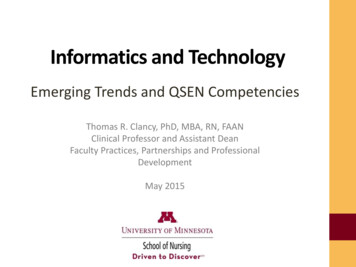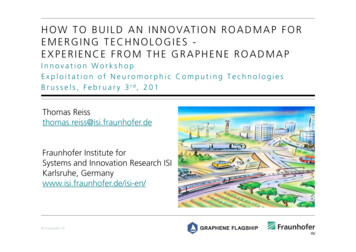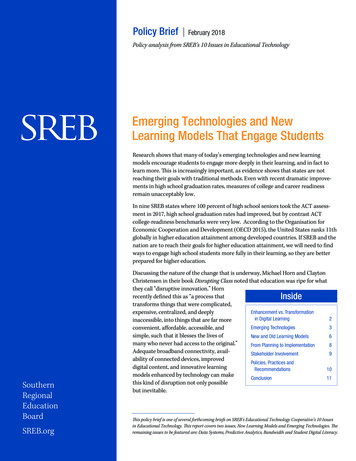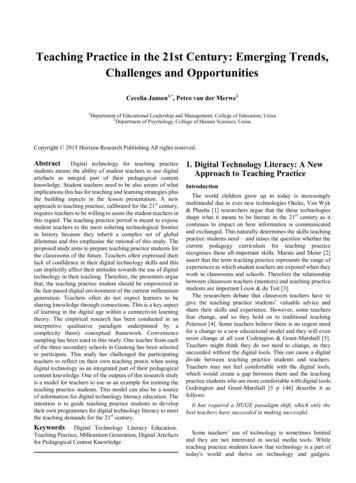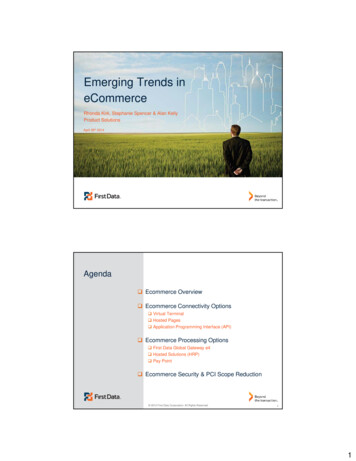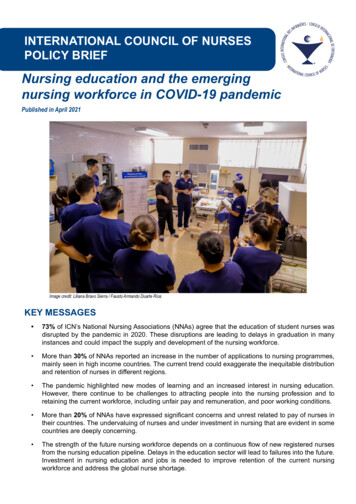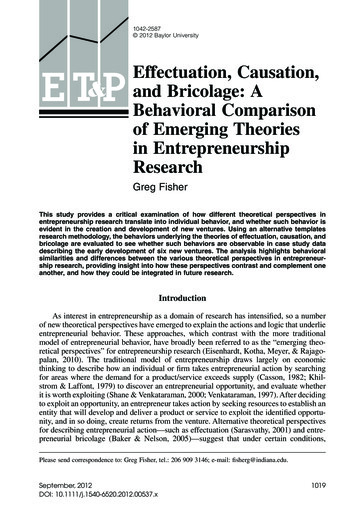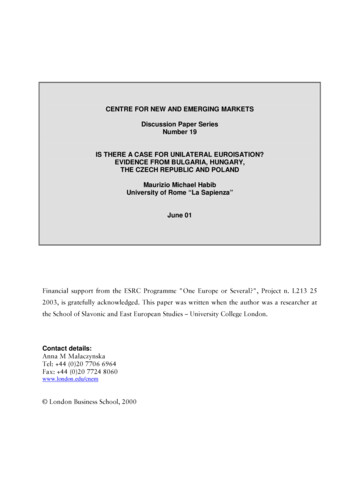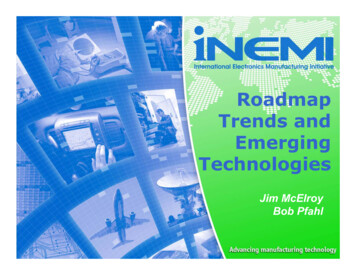
Transcription
RoadmapTrends andEmergingTechnologiesJim McElroyBob Pfahl
Topics iNEMI Overview 2007 iNEMI Roadmap Research Priorities– Key Gaps By Roadmap Areas By Research Areas– Projects to address iNEMI Strategic Thrusts– Pb-free Conversion: Current Situation Conclusions and Summary1
The iNEMI Mission:Advancing Manufacturing sBuild toOrderInformation TechnologyLogisticsCommunicationsBusiness PracticesManufacturingCollaborativeDesigniNEMI PROCESS FUNNELIdentify and close technology gaps, which includesthe development and integration of the electronicsindustry supply infrastructure.Accelerateddeployment ofnew technologiesDissemination ofefficient businesspracticesDevelopment ofindustryinfrastructureStimulation ofstandardsCustomerDeliverables2
2007 iNEMIRoadmap
Statistics for the 2007 Roadmap 500 Participants 265 Companies/organizations 17 Countries from 4 Continents 19 Technology Working Groups (TWGs)(added Organic & Printed Electronics) 5 Product Emulator Groups (PEGs) Over 1300 Pages of Information Roadmaps the needs for 2007-20174
2007 Roadmaps19 Individual Roadmap Chapters Semiconductor Technology Packaging Mass data storage Board Assembly Final Assembly Environmentally ConsciousElectronics Interconnect SubstratesOrganic Interconnect SubstratesCeramic Connectors RF Components & SubsystemsOptoelectronicsPassive ComponentsEnergy Storage SystemsOrganic & Printed ElectronicModeling, Simulation & DesignToolsThermal ManagementTest, Inspection & MeasurementProduct Lifecycle InformationManagementSensors5
9 Contributing iconductorsiNEMIiNEMIBoardBoardAssyAssyTWGTWGiNEMI anagementManagementTWGTWGSupply orageTWGTWGMagnetic andOptical StorageOptoelectronics andOptical Storage6
The Changing Industry Consumers are concerned about the impacts that electronicsproducts may exert regarding safety, energy usage, andenvironmental impact.There has been a dramatic movement of manufacturing andmanufacturing support to China from North America, Europe, andother Asian countries because of:– A low-cost, highly skilled workforce– A massive market opportunity. The increasing scope of outsourced operations requires looselycoupled business processes spanning multiple companies andcontinents.Business models in the electronics industry have changed leading to significant shifts in roles and responsibilities acrossthe supply chain.7
Strategic ConcernsValue Creation in the Supply Chainls17.034bes-chainElectronicMaterials 81BnTypicalCompaniesActiveComponents 228BnSumitomo Bakelite, Intel, STMicro,DuPont, AblestikLSI LogicIC AssemblyServices 8.8BnPassiveComponents 197BnEMSAssembly 127Bn2005FinishedEquipment 1,126BnAmkor,ASE, SPILTyco, Molex,AVX, SharpSolectron,Sanmina-SCI,FlextronicsDell, HP, Cisco,Nokia, Teradyne,Visteon, 10%15%8%8%2%8%7%15%2%5% 1%8% 8Bn 34Bn 0.7Bn 16Bn 3Bn 90Bn 6Bn 34Bn 0.2Bn 10Bn 1Bn 90Bn4%24%R&DMarginValueR&DValue%TotalR&D64%Source: Prismark Partners8
Changing Regulations Environmental legislation in various product segmentsrequires the electronics industry to share detailed materialcontent data of their products and components. To meet regional legislative requirements, manufacturersmust remove environmental “Materials of Concern,” suchas lead. A number of “High Reliability” product manufacturers aretaking Pb exemptions under the EU RoHS, and requestinga dual supply chain for components. The electronics industry is facing end-of-life or producerresponsibility legislation.9
Market Growth Worldwide production of computers and office equipment isexpected to reach 431Bn in 2006, and grow at an average rate of5.4% per year to reach 532Bn in 2010.Global production of communications equipment is expected toreach 176Bn in 2006, representing about 15% of the electronicsindustry.Portable and consumer electronics production will reach 267Bnin 2006, following several years of exceptional growth.Medical electronics equipment production will be 53Bn in 2006,accounting for about 4% of the global electronics industry.In 2006, over 3Bn SiPs were assembled. By 2010, this number isexpected to reach 6.65Bn, growing at an average rate of about17% per year.10
Converging Markets Medical-Consumer Automotive-Entertainment Communication-Entertainment Computing-Entertainment11
Emerging Technology The end of traditional semiconductor scaling. Reduction of emphasis on the microprocessor frequencymetric, and the corresponding increase in importance ofthe system’s throughput metric. Higher bandwidth to and from the microprocessor. Increased need for improved cooling & reduced power. Minaturization including 3D Packaging. Disruptive technology offers opportunity for innovation. Inorder to ensure success, the supply chain must be willingto invest with a long-term perspective in mind. The 2007 roadmap did not identify a major need for opticaltransmission within high performance printed wiringboards during the next decade. Growth in silicon device size is slowing.12
ResearchPriorities
Leadership through Innovation A research vision with threemajor thrusts:– Energy & the Environment– Miniaturization– Medical Electronics14
Research Priorities 2007 gap analysis just completed10 year R&D priorities identifiedAvailable at http://www.inemi.org/cms/ri/Contents:–Technology Research Needs byProduct Sector–Priorities Summarized by ResearchArea Manufacturing ProcessesSystem IntegrationMaterials & ReliabilityEnergy and the EnvironmentDesign–Significant Gaps and Issues fromRoadmap–Options for Innovation15
Key Gaps by Roadmap Area Board Assembly– Low cost fine line/via PCB Technology– Inspection and test capability– Board flex standards– Design for Manufacturing standards Environmentally Conscious Electronics– Alternatives to Cd, Hg, CrVI, PBB, and PBDEs– Industry involvement in policy making on material restrictions– Scientific methodologies to assess environmental impact of materials– Effective basic energy efficiency metrics Substrates– Low cost, fine line/via PCB Technology– Moisture reliability– High Tg– Low cost, low loss tangent materials16
Key Gaps by Roadmap Area Medical–––– Thermal Management–––– Component reliability standards and standard test methodsStandardized characterization process for RoHS-compliantcomponentsDevelopment of advanced printed circuit board and flexible printedcircuit technologiesSafety study of clinical and home-health wireless environment.Closed Loop, Liquid Cooling SolutionsCooling of 3-D Stacked DiesData Center cooling strategiesReliable low-cost pumpsBoard & System Test–––––Test access for miniaturized productsIncreased adoption of boundary scan in digital and analog devicesTools to determine defect coverage.Standards for board flexure of lead-free BGAsTest solutions for High Density Interconnect17
Key Gaps by Research Area Manufacturing Processes––– Energy and the Environment––– There is a need for a new methodology/strategy for R&D to be conducted inthe global outsourcing environmentThe infrastructure to produce high volume, low cost, high densityinterconnect substrates for portable electronic productsInspection/test technologies need to keep up with density of board designsand component packages.Accepted and sound scientific methods to evaluate environmental impact ofmaterials that are also accepted by regulators, NGOs and industryNew innovative energy sourcesR&D to develop a sustainable infrastructure and viable recycled materialsmarket for use in new products and other applicationsMaterials and Reliability––––Improved Pb-free alloys for better area array shock, lower cost, lowertemperature and reduced copper dissolution issuesHalogen free material for substrates and PCBsSecond level underfill solution needed that is reliable / reworkable and costeffectiveNeed for sensor specific material standards - especially thin films18
Key Gaps by Research Area System Integration––– 3D interconnect structures with associated thermal managementStandardized test methods / figures of merit for printed electronicsThe capability to do system level comparisons (performance,power, and cost) between optical and RF technology from thedevice level to the system level.Design–––Improved, integrated and standardized DfX tools for compatibilityacross supply chainsLow cost solutions for carrying 10Gb/s signal rates betweencomponents on a PCBBetter tools for concurrent design of packages and PCB for bettersystem optimization. Includes metrology andMethodologies for:– Materials characterization and– performance validation19
iNEMIProjects toaddressStrategicThrusts
Emerging Scenario for iNEMI Projects Meet needs of members (both users & suppliers) inkey segments:– High volume/portable Expand & strengthen miniaturization projects– Medical electronics Complete initial Medical Electronics Project & buildmomentum for this segment– High reliability (Telecom, Computing) Establish “End Game” for High Reliability segments for Pbfree conversion:– Close remaining knowledge gaps– Work source of supply issues (BGAs) in the interim Advanced Thermal Management Technologies21
Miniaturization Established Projects– Nano Attach Project– Pb-free Nano-solder Project New Project– Functional Test Coverage Assessment Project – LaunchedJuly 2007 Initiatives– High Temperature Co-planarity Requirements for Componentsand PWBs– RFID Item Level Tag Roadmap and Gap Analysis22
Geckofoot:–14,400 setae/mm2–10 N/cm2–uses only 3% of setae–110 µm long–5 µm diameter–branches to100 to 1,000–0.2 µm long and wide–spatula-shaped endings–100 nN/hairsetae:hair:Adhesion: van der Waals forcesK. Autumn, Y.A. Liang, S.T. Hsieh, W. Zesch, W.P. Chan, T.W. Kenny, R. Fearing, and R.J. Full, “Adhesive Forceof a Single Gecko Foot-Hair”, Nature, 405, 681 (2000).23
Nanotechnology Approaches single sided attachment van der Waals forces 1 – 10 N/cm2 for mm2 to cm2 attachment area 1,600 N/cm2 on point contact attachment[1]Biomimetric Dry Adhesive[1] A.K. Geim et al., Nature Mat., 2003. double sided attachment mechanical & van der Waals forces[2] theoretically 300,000 N/cm2Nano-Velcro[2] S. Berber et al., Phys Rev Lett., 2003.Adhesion Reference: Tape 1s N/cm2, Solder 1,000s N/cm224
Pb Free Nano reflowtemperature.temperature.StrategyImpact Research and develop a nano-solder paste thatcan effectively suppress the melting pointtemperature of Pb-free solders Reduce reflow temperatures which cannegatively affect product reliability, requiretougher qualification requirements forcomponents, and may require significantchanges in manufacturing processes Demonstrate the feasibility of such a solution Demonstrate manufacturability and jointreliabilityIssues: Pb-free materials and products require the use of solders that have higher melting points thanSnPb solder and, therefore, require higher processing temperaturesKey MilestonesPhase 1: research, develop anddemonstrate a nano-solder pasteStatusCompletePhase 2: Demonstrate manufacturabilityOngoingPhase 3: Demonstrate joint reliabilityOngoingPhase 4: Develop/demonstratemanufacturing equipmentOngoing25
Melting Point Suppression of Non-Lead Solder Alloys Nano-particles have higher internal energy vs. bulk materials that results inlower melting temperatures of the particle Nano-scale nonlead solder alloy particles ( 15 nano-meters), couldpotentially melt at 160 C (compared to bulk of 220C – 232C)Bulk, 232 CGold80 % meltingpoint drop !2.5 nmRadiusBuffat and Borel, 1976Tin210 C, 10 nm160 C, 5 nmWronski, 19671/RadiusEvaporated metalsEvaporated metals26
iNEMI RFID Item Level Tag RoadmapILT Roadmap – Why now?– Major barriers exist at ILT RFIDimplementation– To provide RFID stakeholders guidancefor ILT infrastructure and supply chaindevelopment– To drive ubiquitous deployment of RFIDsolutions– The ILT roadmap effort is being driven bythe RFID supply chain members– This roadmap activity is open to all RFIDstakeholders. Your participation is mostwelcome!27
Standards and Roadmap Efforts to Establishthe Printed Electronics InfrastructureStandardsPresentations &PublicationsIEEE 1620 , IEEE 1620.1 , IEEE .org/groups/1620/2/RoadmapsReleased at APEX 2007http://www.inemi.orgPrinted Organic and MolecularElectronics (ISBN 1-4020-7707-6)28
Medical Electronics Established Project– Medical Grade Component Reliability Specifications Initiative– iNEMI Substrates for Medical Devices29
Energy & the Environment Established Projects– Tin Whisker Phase II Project– Lead-Free Rework Optimization Project– Pb-free Wave Soldering Assembly Process Project– Lead-Free Rework Optimization Project– Pb-free BGAs in SnPb Assemblies Project New Project– Halogen-Free Project Phase II – Launch June 2007 New Initiatives– BGA Metallurgy Proliferation– Advanced Thermal Management Technologies (under discussion) High Reliability Task Group– Prioritization of remaining Pb-free knowledge gaps– Strategy for closing gaps– Industry coordination for Pb-free transition30
Pb-freeConversion:CurrentSituation High Volume Markethas converted High Rel. Market hasnot converted
Industry Readiness 9 of 11 Telecommunications OEMs Polled took Pb-
Emerging Technology The end of traditional semiconductor scaling. Reduction of emphasis on the microprocessor frequency metric, and the corresponding increase in importance of the system’s throughput metric. Higher bandwidth to and from the microprocessor. Increased need for improved cooling & reduced power.
